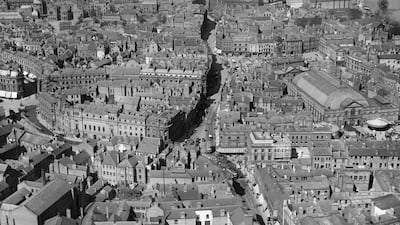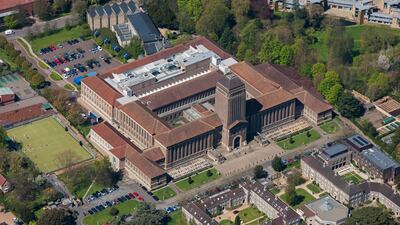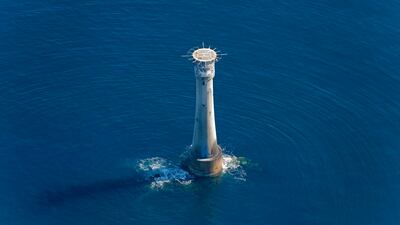Historic England has unveiled a new aerial map of England showing how the nation has evolved over the past century.
Landmarks across England are visible in more than 400,000 images that have been made available using a new aerial photography explorer tool.
The bird's eye views range from Second World War defences and nuclear power stations to Neolithic monuments, Roman farmsteads and medieval villages.
Images from 1919 to the present day have been added to the tool, covering nearly 30 per cent of the English countryside.
About 300,000 of the pictures are the work of Historic England’s Aerial Investigation and Mapping team.
Established in 1967, the team takes photographs of England from the air to discover new archaeological sites, create archaeological maps and monitor the condition of historic sites across the country.
Striking images include a survey of the damage done to the City of London during the Blitz, with St Paul's Cathedral remaining miraculously intact.
Bomb damage can also be seen in images of central Liverpool and the Albert Dock during and after the Second World War.
Other photographs show England's coast from the air, including the 19th century Bishop's Rock lighthouse and the remains of Fort Godwin in Yorkshire, which was used as a gun battery during both world wars.
Duncan Wilson, Historic England’s chief executive, said: “I am delighted that our new online tool will allow people to access easily our wonderful collection of aerial images and enjoy the historic photography that our team uses every day to unlock the mysteries of England’s past.”
Nigel Huddleston, the heritage minister, said the tool offered “a bird’s eye view of our past” and encouraged “everyone to explore the thousands of English sites from the last century”.
COMPANY%20PROFILE
%3Cp%3EFounder%3A%20Hani%20Abu%20Ghazaleh%3Cbr%3EBased%3A%20Abu%20Dhabi%2C%20with%20an%20office%20in%20Montreal%3Cbr%3EFounded%3A%202018%3Cbr%3ESector%3A%20Virtual%20Reality%3Cbr%3EInvestment%20raised%3A%20%241.2%20million%2C%20and%20nearing%20close%20of%20%245%20million%20new%20funding%20round%3Cbr%3ENumber%20of%20employees%3A%2012%3C%2Fp%3E%0A
MATCH INFO
Champions League quarter-final, first leg
Manchester United v Barcelona, Wednesday, 11pm (UAE)
Match on BeIN Sports
Emergency phone numbers in the UAE
Estijaba – 8001717 – number to call to request coronavirus testing
Ministry of Health and Prevention – 80011111
Dubai Health Authority – 800342 – The number to book a free video or voice consultation with a doctor or connect to a local health centre
Emirates airline – 600555555
Etihad Airways – 600555666
Ambulance – 998
Knowledge and Human Development Authority – 8005432 ext. 4 for Covid-19 queries
UAE currency: the story behind the money in your pockets
The Matrix Resurrections
Director: Lana Wachowski
Stars: Keanu Reeves, Carrie-Anne Moss, Jessica Henwick
Rating:****
RESULTS
%3Cp%3E%0D5pm%3A%20Al%20Maha%20Stables%20%E2%80%93%20Maiden%20(PA)%20Dh80%2C000%20(Turf)%201%2C400m%0D%3Cbr%3EWinner%3A%20AF%20Alfahem%2C%20Tadhg%20O%E2%80%99Shea%20(jockey)%2C%20Ernst%20Oetrel%20(trainer)%0D%3Cbr%3E5.30pm%3A%20Al%20Anoud%20Stables%20%E2%80%93%20Handicap%20(PA)%20Dh80%2C000%20(T)%201%2C200m%0D%3Cbr%3EWinner%3A%20AF%20Musannef%2C%20Tadhg%20O%E2%80%99Shea%2C%20Ernst%20Oertel%0D%3Cbr%3E6pm%3A%20Wathba%20Stallions%20Cup%20%E2%80%93%20Handicap%20(PA)%20Dh70%2C000%20(T)%201%2C400m%0D%3Cbr%3EWinner%3A%20AF%20Rasam%2C%20Tadhg%20O%E2%80%99Shea%2C%20Ernst%20Oertel%0D%3Cbr%3E6.30pm%3A%20Arabian%20Triple%20Crown%20Round%202%20%E2%80%93%20Group%203%20(PA)%20Dh%20300%2C000%20(T)%202%2C200m%0D%3Cbr%3EWinner%3A%20Joe%20Star%2C%20Tadhg%20O%E2%80%99Shea%2C%20Helal%20Al%20Alawi%0D%3Cbr%3E7pm%3A%20Liwa%20Oasis%20%E2%80%93%20Group%202%20(PA)%20Dh300%2C000%20(T)%201%2C400m%0D%3Cbr%3EWinner%3A%20AF%20Alajaj%2C%20Tadhg%20O%E2%80%99Shea%2C%20Ernst%20Oertel%0D%3Cbr%3E7.30pm%3A%20Dames%20Stables%20%E2%80%93%20Handicap%20(TB)%20Dh80%2C000%20(T)%201%2C400m%0D%3Cbr%3EWinner%3A%20Silent%20Defense%2C%20Oscar%20Chavez%2C%20Rashed%20Bouresly%3C%2Fp%3E%0A
HOW TO WATCH
Facebook: TheNationalNews
Twitter: @thenationalnews
Instagram: @thenationalnews.com
TikTok: @thenationalnews
Labour dispute
The insured employee may still file an ILOE claim even if a labour dispute is ongoing post termination, but the insurer may suspend or reject payment, until the courts resolve the dispute, especially if the reason for termination is contested. The outcome of the labour court proceedings can directly affect eligibility.
- Abdullah Ishnaneh, Partner, BSA Law



























